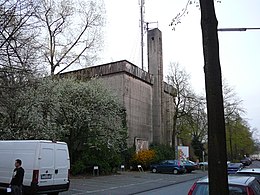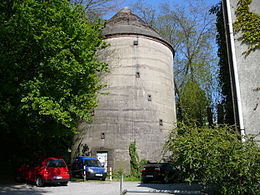Air raid shelters in Wuppertal
To protect the population from bombing raids during the Second World War , numerous air raid shelters were set up in Wuppertal during the National Socialist era , which protected many people, especially during the nights of bombing in 1943 .
Air raid tunnels
The air raid shelters included more than 400 air raid tunnels in the city, of which the Hardthöhlen is the most famous. But the rest of the city was also provided with such shelters across the board, most of which are no longer accessible today.
High bunker
The high bunkers , which were mainly built in the densely populated city districts, are characteristic of the cityscape .
- Republic Square, Elberfeld (demolished in 2009)
- Am Pfaffenhaus, Katernberg (softened, conversion to a residential building, according to documents Pfaffenhaus, but in reality Metzmachersrath 24)
- Siedlungsstraße, Barmen (demolished in 2015 except for the floor slab, on which a multi-generation residential park was built)
- Schwelmer Straße, Langerfeld (2007 sale by the federal government, 2010–2011 renovation work, 2011–2019 building ruins, after several failed attempts in August 2017 successful resale, but new renovation work will not start until the end of 2019)
- Schusterstraße, Elberfeld (available, private property)
- Great hook road, Barmen (available)
- Friedrichsplatz, Elberfeld (demolished, not completed)
- Ascheweg, Ronsdorf (softened?)
- Münzstraße, Barmen (available)
- Municipal hospitals Barmen (operating room bunker)
There were also special Winkel-type air defense towers in Wuppertal.
- Else-Lasker-Schüler-Straße / Unterstraße, Elberfeld (available, city of Wuppertal is the owner, rented out as a warehouse)
- Heubruch, Barmen (popularly called "Sugar Loaf", demolished)
- Heckinghauser Strasse, Heckinghausen (demolished)
Easter tree
In the Ostersbaum residential area there was a bunker built in 1941/1942 on the Platz der Republik on Hagenauer Straße . The bunker had 4 floors with a volume of 18,000 cubic meters and wall thicknesses of up to 1.2 meters. The floor slab was 2 meters thick and the ceiling 1.6 meters thick. ( 51 ° 15 '55.1 " N , 7 ° 9' 4.4" E ) . After the Second World War, the bunker served as an emergency shelter until 1957 and then briefly achieved regional fame as a “ jazz cellar”. A beverage market moved into the building at the end of the 20th century. The demolition of the bunker was decided in 2008 and began in January 2009.
Smaller is the 21 meter high angle tower , a round high-rise bunker on the lower street of the Winkel type ( 51 ° 15 ′ 37 ″ N , 7 ° 9 ′ 6.5 ″ E ) . The angle tower, which could accommodate up to 500 people, was built by the Brüggemann company.
North city
The 21.5 meter high bunker on Schusterstrasse in the Nordstadt residential area was built in 1942/1943. ( 51 ° 15 '25.1 " N , 7 ° 8' 4.4" E ) . Its base is 20 by 20 meters, its wall thickness is 1.1 meters. The seven floors have a storey height of 2.7 meters with a false ceiling height of 25 centimeters. Like the walls, the ceiling is made of reinforced concrete and is 1.4 meters thick. Its two attached entrances on the ground floor had gas locks . The high bunker is identical to the high bunker on Nussbaumstrasse in the Rott residential area.
Red
In the residential area of Rott , at the corner of Nussbaumstrasse and Grosse Hakenstrasse, there is a bunker built in 1942/1943 ( 51 ° 16 ′ 18.7 ″ N , 7 ° 11 ′ 16.7 ″ E ) . The seven-storey high bunker is identical to the high bunker on Schusterstraße in the north of the city.
Sedansberg
A bunker in the residential district Sedan Berg at Münzstraße corner gulls road ( 51 ° 16 '31.4 " N , 7 ° 11' 50.3" O ) .
A second bunker was on the settlement road . This was partially demolished and senior citizens' apartments are to be built on the foundation by 2016. ( 51 ° 16 ′ 48.3 ″ N , 7 ° 11 ′ 40.7 ″ E )
Langerfeld-Mitte
In the residential area of Langerfeld-Mitte , at Schwelmer Strasse at the corner of Preußenstrasse, there is a bunker 26.70 meters long, 14.5 meters high and 15 meters wide. ( 51 ° 16 ′ 33.5 ″ N , 7 ° 15 ′ 5.8 ″ E ) The walls, ceilings and foundation are made of reinforced concrete. It provided shelter for 670 people (372 berths and 298 seats) on three floors. This bunker also served as emergency shelter for bombed-out families after the Second World War. In March 2010, the conversion to a residential building with 14 barrier-free rental apartments for senior citizens began. The conversion costs were put at 1.8 million euros. After the windows were broken through and installed, work came to a standstill in mid-2012. At the beginning of 2016 the building of the former bunker was foreclosed.
Post-war shelters
Even after the Second World War, shelters were kept for the population. They were supposed to protect against attacks with NBC weapons during the Cold War . The largest facility of this type from the Second World War with space for 2000 people was located below the bus station at Wuppertal main station , the Döppersberg traffic junction . The system is still there, but is no longer used as a shelter. A discotheque and an event room for cultural events are to be built here by the end of 2018.
Another modernized air raid shelter is located under the Neumarkt in front of the old Elberfeld town hall . The corridors run under the market, there are wooden benches and exits to more than 40 rooms. 450 people can find shelter under the Neumarkt.
Web links
- Pictures of bunkers and air raid shelters on wuppertal-untertage.de ( Memento from April 2, 2015 in the Internet Archive )
- Private photo collection of the Wuppertal bunker
- Wuppertal air raid shelter , on LostAreas.de
- Wuppertal air raid shelter , on LostAreas.de
- Neumarkt-Bunker Wuppertal , on LostAreas.de
Videos:
- WZ-TV: Forgotten bunkers in Wuppertal , "Neumarkt" bunker
- WDR local time - interior shots of the bunker "Platz der Republik"
Individual evidence
- ↑ Claudia Kasemann and Manuel Praest: Bunker: The work rest. Westdeutsche Zeitung , August 7, 2012, accessed on March 8, 2016 .
- ↑ Michael Bosse: The bunker in Wuppertal-Langerfeld should keep its rough charm. Westdeutsche Zeitung , December 11, 2019, accessed on August 4, 2020 .
- ↑ a b wuppertal-untertage.de
- ↑ Jörg Jung: Sedansberg: Living on the bunker site. In: Westdeutsche Zeitung of July 16, 2013
- ↑ WZ-online.de, September 26, 2007 , visit: Unheimlicher Bunker
- ↑ WZ-online.de, January 8, 2007 , Langerfeld: Beautiful living in the bunker
- ↑ WZ-online.de, August 7, 2012 , Bunker: The work is resting
- ↑ WZ-online.de, November 10, 2015
- ^ Andreas Boller: Markus and Thomas Riedel convert bunkers into clubs . In: Westdeutsche Zeitung of January 4, 2017.
- ↑ WZ-online.de, December 18, 2008 ( page no longer available , search in web archives ) Info: The link was automatically marked as defective. Please check the link according to the instructions and then remove this notice. , Neumarkt: Bunker entry in the criticism




